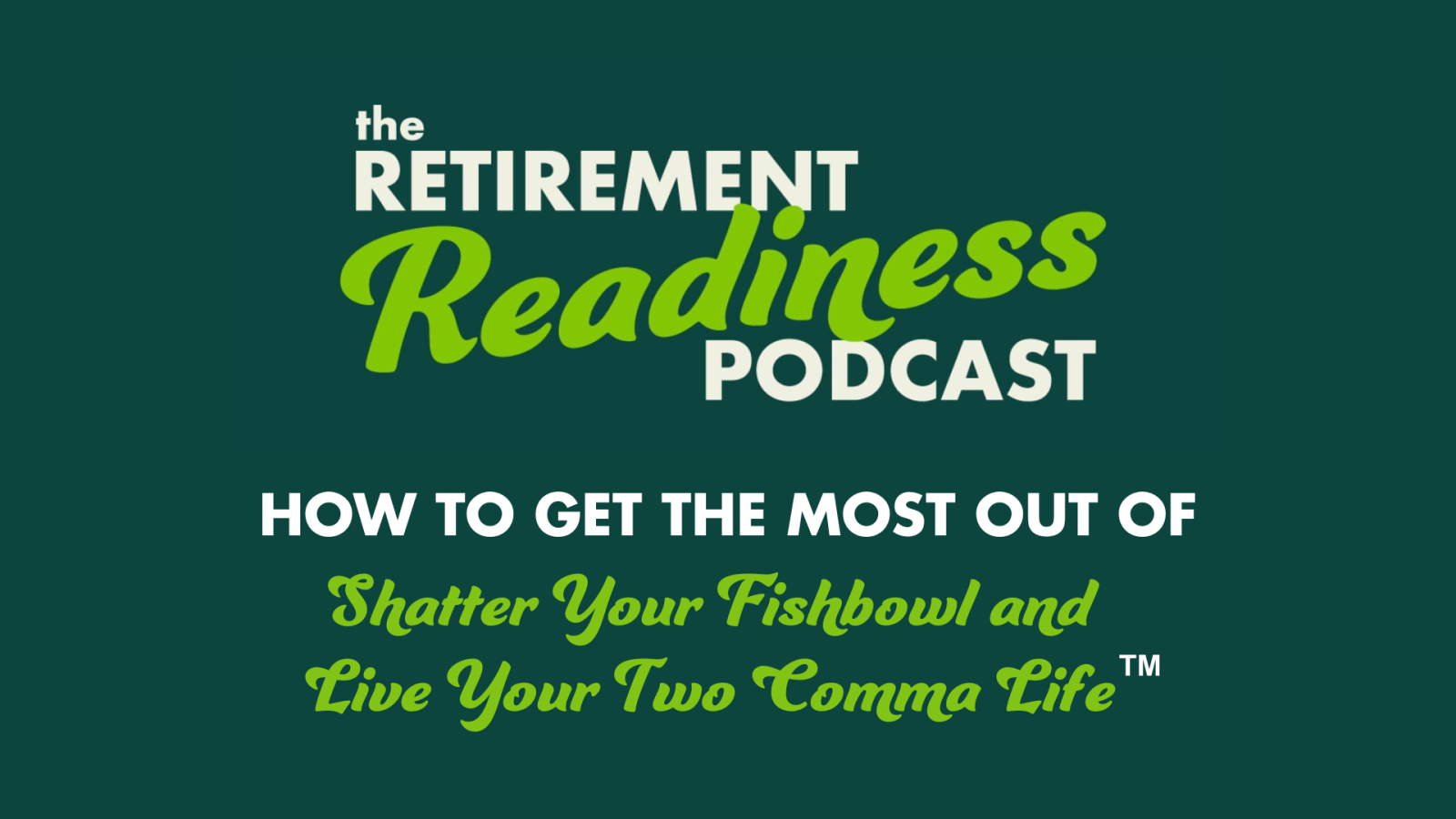#82: How to Get the Most Out of Shatter Your Fishbowl and Live Your Two-Comma Life®
When it comes to personal growth, most of us have picked up a book or listened to a podcast that inspired us — only to put it down and forget most of it within a week. The ideas were good, but they didn’t stick. Why?
Because everyone learns and processes differently. Some people need to write things down. Others think best while reflecting quietly. Some thrive with structured exercises, while others prefer stories that slowly shift the way they see the world.
That’s exactly the challenge Tim Regan wanted to solve when he created the new book Shatter Your Fishbowl. In a recent episode of the Retirement Readiness Podcast, they shared how the book blends storytelling, practical exercises, and flexible tools so every reader can take something meaningful away.
A Book Designed for Every Kind of Learner
Most self-help or financial books fall into one of two camps:
- Narrative-driven. They tell inspiring stories and share big ideas but leave readers wondering, Now what?
- Workbook-style. They offer plenty of questions and activities, but can feel overwhelming if you’re not the type to fill in every blank.
Shatter Your Fishbowl combines both approaches. At the end of each chapter, readers will find thoughtful prompts that encourage reflection and action. But there’s no one right way to use them. If you’re someone who loves to journal, you’ll find space to do that. If you’d rather keep index cards nearby and jot down thoughts as you go, that works too. And if you prefer to simply read, reflect, and let the ideas marinate — that’s perfectly fine.
“The whole idea is that you don’t want to read a chapter and walk away with no clue what to do. The questions and exercises are there if you want them — but the book is meant to meet you where you are.”
Slow Down and Let It Sink In
One of the most valuable insights from the podcast episode was the importance of taking your time.
When you first read the book, it’s easy to fly through the chapters because the stories can pull you in — and you might skip right over the questions at the end. These questions may not be ones you need to answer ton the spot, but they are an invitation to pause, think, and come back when you’re ready.
One tip: before going to bed, write down a few questions about what you’ve read. Your subconscious brain is a problem-solving machine, and when you frame things as questions rather than commands, your mind will keep working on them overnight.
For example:
- Instead of saying, “I need to budget better,” ask, “What’s one small step I can take to feel more in control of my money?”
- Instead of saying, “I should stop procrastinating,” ask, “What would make it easier for me to take the first step tomorrow?”
Small shifts in how you think lead to big changes in what you do.
Mindset, Money Set, and the Two-Comma Life®
Another unique feature of the book is how it’s structured. There are really main three parts:
- Mindset – Stories and reflections to help readers see challenges differently.
- Money Set – A practical section that applies those mindset shifts to personal finance, building a foundation for financial freedom.
- Epilogue – A meaningful conclusion that ties everything together.
The phrase “Two-Comma Life®” refers to a life where financial decisions support your purpose — and your bank account reflects stability (yes, two commas = a seven-figure mindset). But it’s not just about the money. It’s about designing a life that feels abundant, free, and aligned with what matters most to you.
“It’s your Two-Comma Life® — not the Two-Comma Life®. Everyone’s version will look different. The goal is to equip you with the tools to create yours.”
Don’t Do It Alone
One of the recurring themes in both the book and the podcast is community. Growth sticks better when you talk about it.
That might mean:
- Reading the book with a friend or small group.
- Sharing your takeaways with a mentor or spouse.
- Emailing the PrairieView team to ask a question as you work through the material.
Tim pointed out that some of his best conversations with Maddy have come from comparing how each of them interprets an idea. The same chapter can spark completely different reflections — and that’s the point.
The Regans hope readers will not just passively consume Shatter Your Fishbowl, but engage with it, talk about it, and even reach out to share how they’re living their Two-Comma Life®.
Final Thoughts
Books don’t change lives — action does. But the right book, read the right way, can spark new ways of thinking that lead to lasting change.
Shatter Your Fishbowl isn’t just another self-help book. It’s a flexible tool for breaking out of limiting patterns, building a healthier relationship with money, and defining success on your own terms. Whether you fly through it in a few days or take it slowly chapter by chapter, the key is to make it your own.
So here’s the challenge: don’t just read it. Live it. Take notes, ask questions, start conversations, and most importantly, apply what resonates.
Because your Two-Comma Life® is waiting — and only you can create it.
👉 Learn more at pv-wp.com and tune in to the Retirement Readiness Podcast for more conversations like this one.





















